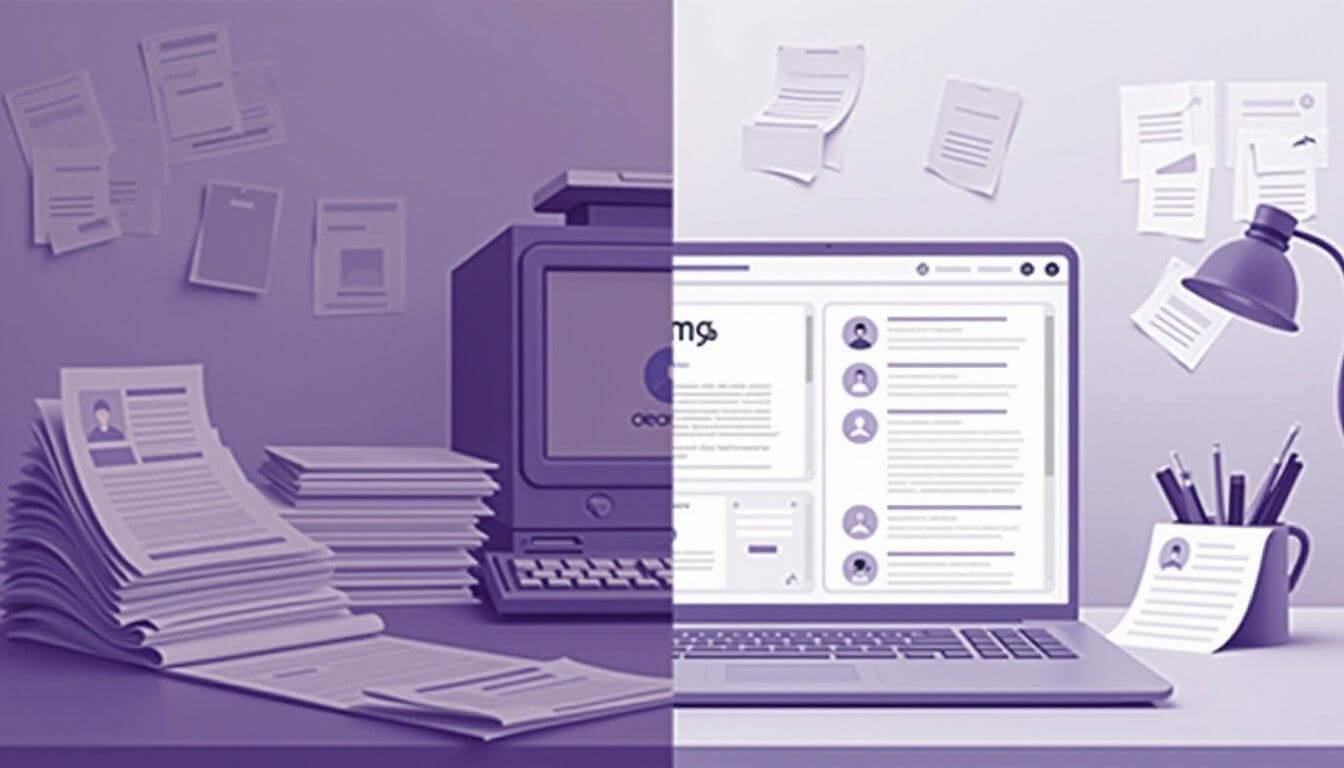
Ever calculated how much that rushed hiring decision actually cost your business? With bad hires costing companies up to 30% of an employee's first-year earnings, getting recruitment right isn't just important—it's essential for your bottom line. Whether you're a startup founder making your first hire or an established business scaling your team, the hiring landscape in 2025 demands a strategic approach that balances technology with human insight.
Ready to transform your hiring process from a costly gamble to a competitive advantage? Let's explore the proven strategies that successful businesses are using to build exceptional teams while avoiding the pitfalls that cause 74% of companies to lose an average of $14,900 per bad hire.
We've helped businesses save $55m with our all-in-one platform. Get instant access to this template and 115+ others, plus AI-powered document creation, starting completely free.
When you're juggling multiple responsibilities in your business, it's tempting to rush through hiring decisions. But here's what those hasty choices really cost: beyond the obvious expenses of recruitment and training, poor hiring decisions drain productivity, damage team morale, and can even harm your company's reputation.
Research shows that 85% of HR decision-makers admit their organisation has made a bad hire, yet many businesses continue using outdated hiring practices. The financial impact extends far beyond salary costs—consider the time your team spends covering for underperforming employees, the disruption to workflows, and the eventual cost of finding a replacement.
What's particularly concerning is that 60% of bad hires occur because employees couldn't produce the required quality of work. This suggests that many businesses aren't effectively evaluating candidates' actual abilities during the hiring process. By implementing proper assessment strategies and taking a more measured approach, you can dramatically reduce these costly mistakes.
The ripple effects of poor hiring extend throughout your organisation. Team members forced to compensate for underperforming colleagues often experience decreased job satisfaction, leading to higher turnover rates among your best employees—creating a costly cycle of recruitment and training.

The most significant shift in recruitment is the move away from credential-focused hiring towards skills-based evaluation. With 81% of companies now using skills-based hiring compared to just 56% in 2022, this approach has proven its effectiveness in finding candidates who can perform the job requirements.
Instead of filtering candidates based solely on degrees or years of experience, focus on assessing the specific skills needed for success in the role. Create practical assessments that mirror real job tasks, allowing candidates to demonstrate their capabilities rather than just discuss them. This approach not only widens your talent pool but also helps identify high-potential candidates who might have been overlooked using traditional screening methods.
While AI can reduce time-to-hire by up to 40%, the key is using it to enhance rather than replace human judgment. Utilise AI tools for initial resume screening, scheduling, and administrative tasks, while ensuring human recruiters assess cultural fit, soft skills, and growth potential.
The most successful organisations are combining AI efficiency with human insight. Automated systems can quickly identify candidates with the right technical qualifications. Still, only human interaction can assess whether someone will thrive in your specific work environment and contribute positively to team dynamics.
Vague job descriptions are one of the biggest hiring mistakes businesses make, leading to mismatched expectations and poor hiring decisions. Your job postings should clearly outline:
When candidates understand exactly what you're looking for, you'll attract applicants who are genuinely suited to the position, saving time and reducing the likelihood of hiring mistakes. Remember to use our document signing feature to streamline the contract process once you've found your ideal candidate.
Creating a positive candidate experience strengthens your employer brand and increases offer acceptance rates. In a competitive talent market, how you treat candidates during the hiring process directly impacts your ability to attract top talent.
Keep communication clear and timely throughout the process. Set expectations about timelines and next steps, and honour those commitments. Even if a candidate isn't selected, a respectful and professional experience ensures they'll speak positively about your company—protecting your reputation in an increasingly connected world.

Focusing solely on active job seekers means missing out on exceptional talent who might be perfect for your organisation but aren't actively looking. Build relationships with potential candidates through networking, social media engagement, and employee referrals—even when you're not actively hiring.
Creating a talent pipeline ensures that when positions open, you have pre-qualified candidates ready to engage. This proactive approach reduces time-to-hire and often results in better cultural fits, as these candidates have had time to learn about your company organically.
The hiring process doesn't end with a signed contract. Poor onboarding experiences cause 1 in 10 employees to leave, wasting all the time and resources invested in recruitment. Conversely, companies with effective onboarding see 82% better retention rates.
Develop a comprehensive onboarding programme that goes beyond paperwork and basic training. Include cultural integration, clear goal-setting, and regular check-ins during the first 90 days. Our template library includes onboarding checklists and employee handbooks to help you create a structured process that sets new hires up for success.
Companies embracing inclusive hiring practices report 35% growth in DEI-focused recruitment, reflecting both social responsibility and business benefits. Diverse teams bring varied perspectives, leading to better problem-solving and innovation.
Look beyond traditional talent sources. Consider candidates returning from career breaks, those transitioning from different industries, or retirees seeking flexible work arrangements. These often-overlooked candidates can bring valuable experience and dedication to your organisation.

Before beginning your search, establish specific competencies required for success in the role. Companies using competency-based assessments report better hiring outcomes and reduced turnover. Consider both technical skills and soft skills like problem-solving, collaboration, and adaptability.
Create standardised evaluation rubrics that all interviewers use, ensuring consistency and reducing bias in the selection process. This structured approach helps you make objective decisions based on demonstrated capabilities rather than gut feelings.
With 52% of interviewers making decisions within the first 5-15 minutes, it's crucial to design interview processes that allow for genuine evaluation. Move beyond standard questions to include:
Virtual interviews, now standard practice, can save 40% of costs while providing flexibility for both parties. However, ensure your virtual process still allows for meaningful assessment of candidates' abilities and cultural fit.
References remain one of the most reliable ways to verify a candidate's capabilities and work style. Don't skip this crucial step—many bad hires could be prevented through proper reference checking. Ask specific questions about the candidate's performance, reliability, and areas for development.
Go beyond the provided references when possible. LinkedIn and professional networks can help you find additional contacts who've worked with the candidate, providing a more complete picture of their professional history.
Modern ATS platforms do more than store resumes. They provide analytics that help you understand which sourcing channels are most effective and identify bottlenecks in your hiring process. This data-driven approach enables continuous improvement of your recruitment strategies.
Gamified assessments and skills tests increase candidate engagement by 35% while providing objective data about abilities. These tools are particularly valuable for technical roles where specific competencies are crucial for success.
Streamline your hiring paperwork with digital solutions. Our document vault securely stores all employment contracts, compliance documents, and onboarding materials in one accessible location. Combined with our workflow automation, you can reduce administrative burden and focus on finding the right people.
Despite 30% of bad hires resulting from pressure to fill positions quickly, many businesses continue to prioritise speed over quality. While vacant positions impact productivity, the cost of a bad hire far exceeds the temporary inconvenience of a longer search.
Build buffer time into your hiring plans, especially for critical roles. Start recruiting before positions become urgent, allowing for thorough evaluation without compromising standards.
Technical skills can be taught, but cultural alignment significantly impacts long-term success. Assess how candidates' values, work style, and communication preferences align with your team dynamics.
Include team members in the interview process to evaluate interpersonal compatibility. Their insights often reveal whether a candidate will integrate successfully into your existing culture.
Before looking externally, consider whether existing employees could fill the role with appropriate development. Internal promotions boost morale, reduce hiring costs, and often result in faster productivity as these employees already understand your business.
Create clear pathways for advancement and communicate opportunities internally. Our employee profile management feature helps you track skills and development across your team, making it easier to identify internal candidates for new positions.
Effective hiring requires ongoing measurement and refinement. Monitor these essential metrics:
The best hiring strategies evolve based on data-driven insights. Regularly review your metrics, gather feedback from new hires and hiring managers, and adjust your approach accordingly.
Consider conducting stay interviews with successful employees to understand what attracted them to your company and what keeps them engaged. These insights can refine your recruitment messaging and selection criteria.
While the average time-to-fill is 42 days, the ideal timeline depends on your role complexity and candidate availability. For straightforward positions, aim for 2-3 weeks, while executive or specialised roles may require 6-8 weeks. The key is balancing thoroughness with maintaining candidate engagement—communicate regularly to prevent losing top talent to faster-moving competitors.
With 56% of recruiters prioritising soft skills over technical abilities, effective evaluation methods are crucial. Use behavioural interview questions that require candidates to describe specific situations where they've demonstrated skills like leadership, communication, or problem-solving. Supplement interviews with team-based exercises or simulations that reveal how candidates interact and handle challenges in real-time.
Absolutely—AI tools can level the playing field for smaller businesses by reducing time-to-hire by 40% and improving candidate matching. Start with basic automation for resume screening and scheduling, then expand as you become comfortable with the technology. The key is maintaining human oversight to ensure the tools align with your specific needs and company culture.
Focus on comprehensive onboarding and clear expectation-setting from day one. Companies with effective onboarding see 82% better retention, so invest time in creating structured programmes. Regular check-ins during the first 90 days, clear performance goals, and immediate integration into team activities all contribute to long-term retention.
Employee referrals should be a cornerstone of your recruitment efforts—referred candidates are 18 times more likely to be hired than those from other sources. Implement a structured referral programme with clear incentives, and make it easy for employees to submit recommendations. These candidates often integrate more smoothly as they already have internal connections.
Highlight what makes your smaller business unique: flexibility, growth opportunities, direct impact on company success, and closer team relationships. Focus on skills-based hiring to access candidates overlooked by rigid corporate requirements. Emphasise your company culture, offer competitive benefits within your means, and streamline your hiring process to move faster than larger competitors.
Consider contractors for specialised projects, seasonal work, or when testing new roles before committing to permanent positions. However, for core business functions requiring deep company knowledge and long-term commitment, permanent employees typically provide better value. Evaluate the total cost, including training investment, cultural integration needs, and the strategic importance of the role to make the best decision.
Mastering the hiring process in 2025 requires embracing new technologies while maintaining the human touch that identifies truly exceptional candidates. By implementing skills-based assessments, leveraging AI intelligently, and creating outstanding candidate experiences, you'll build teams that drive your business forward while avoiding the costly mistakes that plague outdated hiring practices. Remember, every hire shapes your company's future—invest the time and resources necessary to get it right. Ready to streamline your entire employee management process from hire to retire?
Sign up for a free trial with Business Kitz and discover how our comprehensive platform can transform your hiring documentation, onboarding processes, and ongoing employee management.
Copyright © 2025 Business Kitz 14312161